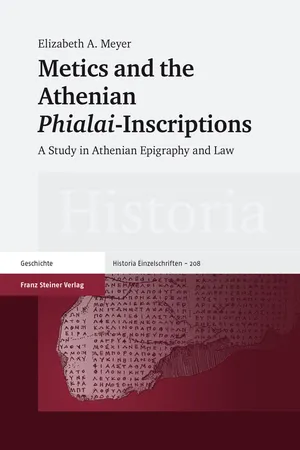
Metics and the Athenian "Phialai"-Inscriptions
A Study in Athenian Epigraphy and Law
- 218 pages
- English
- PDF
- Available on iOS & Android
Metics and the Athenian "Phialai"-Inscriptions
A Study in Athenian Epigraphy and Law
About this book
Beneath the shining world of the citizen of Classical Athens was the perilous shadow-realm of the resident foreigner, the metic. Emblematic of the status of metic was the requirement to pay a special metic tax, the metoikion. And if a metic failed to pay this tax, he or she would be sold into slavery, a fate that threatened no citizen of the classical Athenian polis. In the late fourth century BC the Athenians, in the face of widespread departure of metics in the face of economic recession and legal harassment, moved to improve metics' legal situation in order to entice metics back to Athens.
It is to the context of these legal reforms of the metic condition, this volume argues, that a celebrated set of fourth-century BC Athenian inscriptions recording dedications of silver cups, phialai, belong. Known since the nineteenth century as the "Attic Manumissions", these inscriptions have been thought to be the result of a legal process by which slaves were set free. Here these inscriptions are published as a corpus for the first time. And it is argued that they represent not the freeing of slaves, but preserve instead the traces of prosecutions of metics for failure to pay the metoikion. In the new pro-metic atmosphere of the 330s BC, persons who sued metics for failing to pay the metic tax, but did not win a conviction, were fined to discourage frivolous suits, and part of that fine was dedicated to divinity in the form of a phiale.
Frequently asked questions
- Essential is ideal for learners and professionals who enjoy exploring a wide range of subjects. Access the Essential Library with 800,000+ trusted titles and best-sellers across business, personal growth, and the humanities. Includes unlimited reading time and Standard Read Aloud voice.
- Complete: Perfect for advanced learners and researchers needing full, unrestricted access. Unlock 1.4M+ books across hundreds of subjects, including academic and specialized titles. The Complete Plan also includes advanced features like Premium Read Aloud and Research Assistant.
Please note we cannot support devices running on iOS 13 and Android 7 or earlier. Learn more about using the app.
Information
Table of contents
- Contents
- Acknowledgments
- Introduction
- Part I. History
- Part II. Epigraphy
- List of Photographs
- Works Cited
- Indices